- Print
- DarkLight
- PDF
This article will give you a brief introduction to Cirrus and all the functionalities on our platform.
Wide range of functionalities
At Cirrus we believe that the key to success is not only deliver a wide range of functionalities, but also to make those functionalities accessible and easy to use.
We spend considerable time and resources on making the platform as intuitive as possible. And we follow guidelines set out by User Experience experts like Jakob Nielsen and Steve Krug.
Our motto is: easy for beginners and advanced for experienced users.
Overview of the Cirrus platform
We are very happy to have you on board!
Cirrus is an end-to-end e-assessment platform, which means that Cirrus supports the entire assessment process.
As our highly valued Cirrus customer you now have access to:
- A proven technology delivering hundreds of thousands of high-stakes assessments around the globe
- A modern application based on the latest web-technologies and easy to use interface that users love
- Rapid development with great innovative features
- Supporting international open standards
- A clean and easy to use interface
- Unlimited scalability due to modern technology and state-of-the-art hosting through AWS
- Using elastic load balancing (hosting centres globally, including Europe, South Africa and North America)
- A very secure solution using military grade encryption
- Only e-assessment platform in the world offering high-stakes solution for mathematics and economics
- Seamless integrations with various remote proctoring solutions, Microsoft Office365, ReadSpeaker, SOWISO and Creatio.
The Cirrus workflow
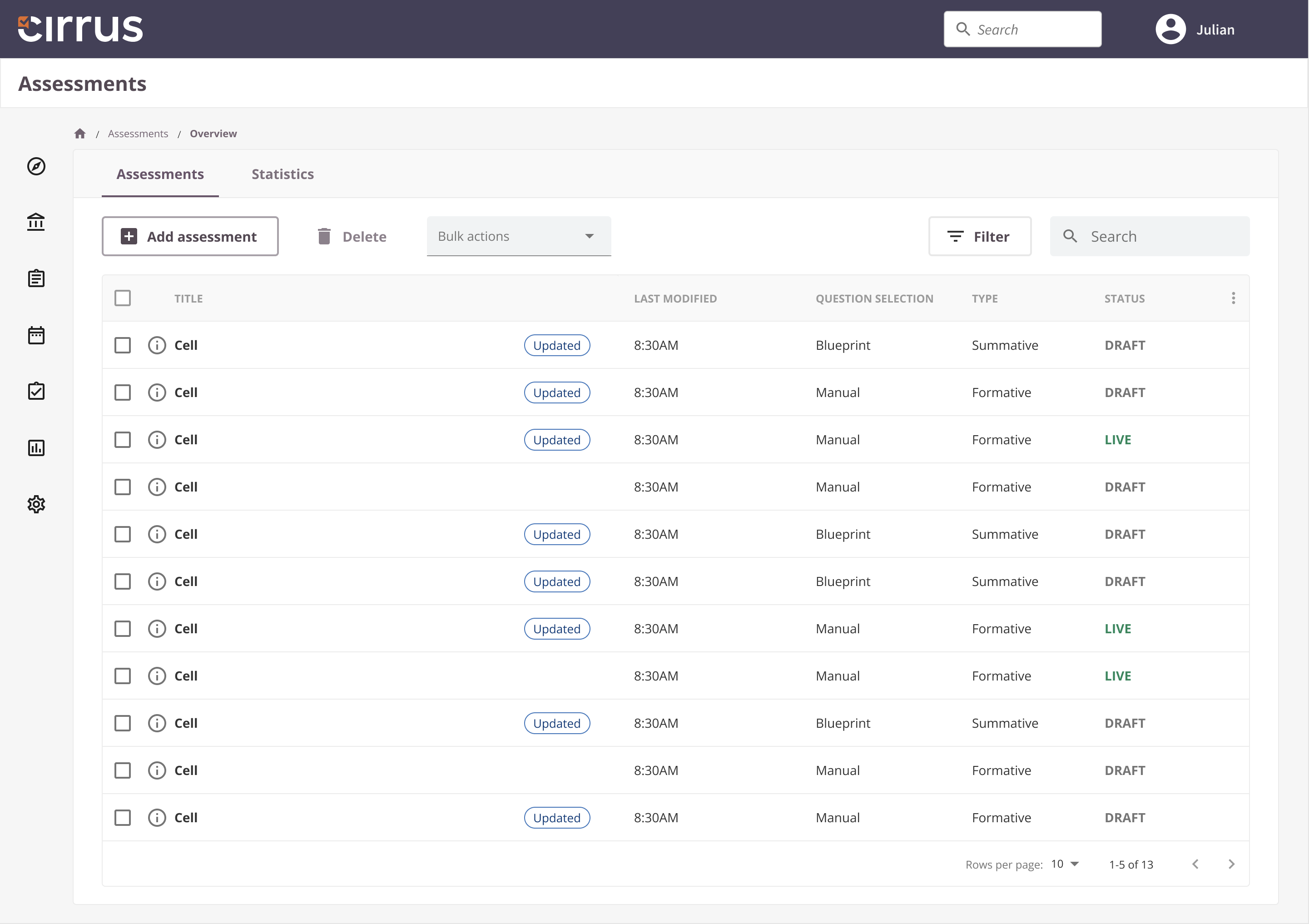 A clean and easy to use interface
A clean and easy to use interface
From now on you have access to a simple yet powerful end-to-end e-assessmentprocess tool.
Creating and administering assessments becomes so much easier with Cirrus!
We can even describe the whole process in just 1 sentence:
Work your way from top to down, from left to right.
This process starts at the top with step 1 and ends at the bottom with step 5. During each step, you complete one or a few tabs, from left to right.
Creating and administering high stake tests in 5 steps
This is being done on the basis of 5 simple steps:
- Creating Item banks in the Library
- Creating Assessments
- Delivering Assessments
- Marking Process
- Get Reports
Following these steps will enable you to:
- Build an extensive database including a wide range of question items
- Compose exams; from simple tests to high stake assessments
- Schedule and deliver exams to your candidates
- Arrange for invigilation
- Manage the marking process
- Pull reports on all results
Let's have a look at them step by step.
1. The Library
Before you can create assessments, you first have to build a Library. This is your foundation.
In the Library you can setup collections consisting of questions. How you complete this, is up to you. For example you can create a collection per question type, subject area, learning objective, etc. You can also store media elements in the Library to be used in questions or as resource files.
Currently you can use as many as 20 different question types, divided into open and closed question types.
Closed question types
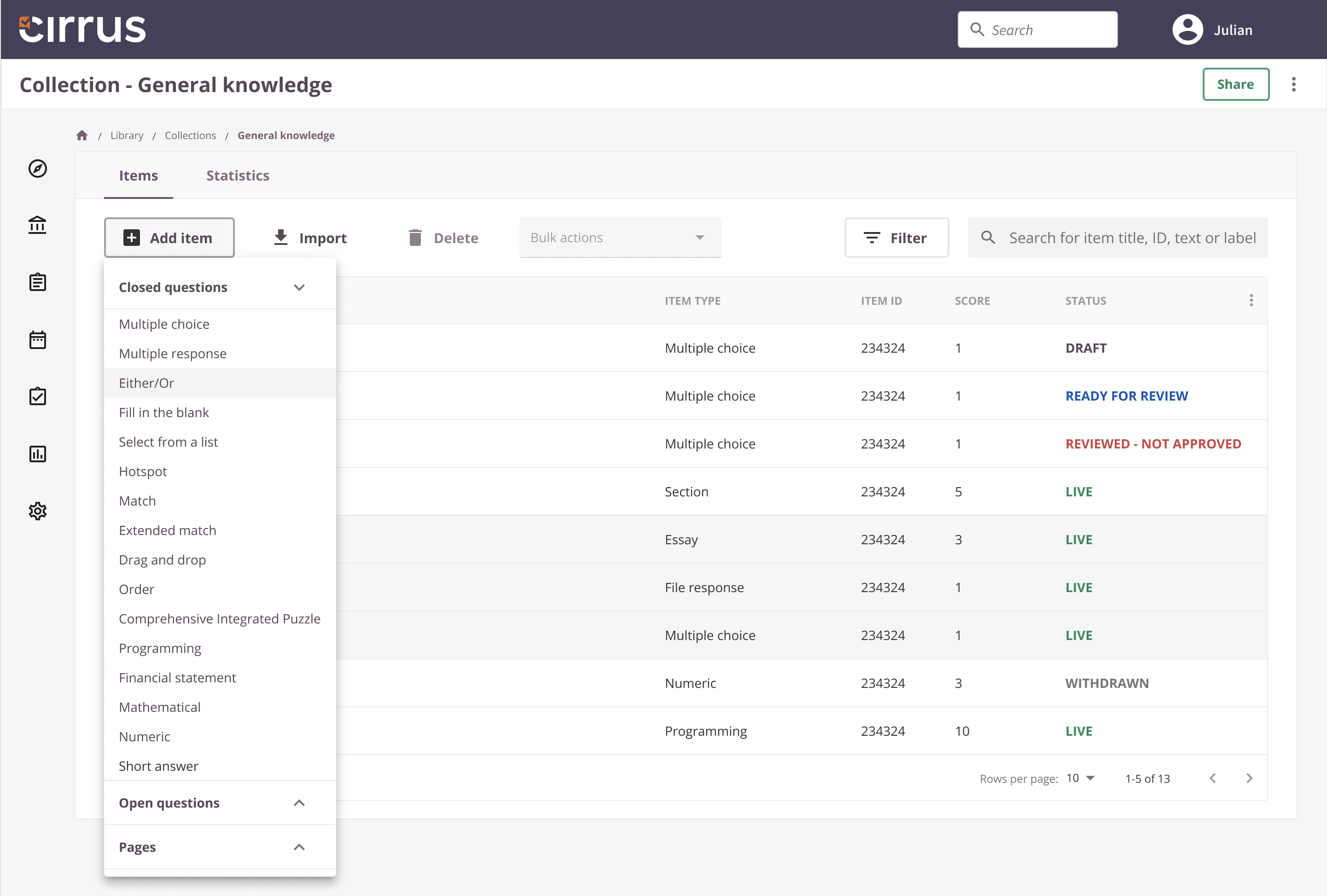 Available question types in CirrusMost of the question types in Cirrus are auto-scored, including multiple choice questions. Questions are very easy and intuitive to create and follow a workflow (draft, ready for reviewed, live, withdrawn). In this way you can ensure the quality of the items because they need to be approved before being set to Live.
Available question types in CirrusMost of the question types in Cirrus are auto-scored, including multiple choice questions. Questions are very easy and intuitive to create and follow a workflow (draft, ready for reviewed, live, withdrawn). In this way you can ensure the quality of the items because they need to be approved before being set to Live.
Open answer questions
Cirrus supports and advanced marking workflow for open answer questions (essay / file upload). Multiple markers and moderation is supported. Markers can annotate directly into the submission of the candidates.
Other question types
Cirrus supports a wide range of question types. Most of these are auto-scored. Some of the functionalities we would like to highlight are the interactive question types like hotspot, matching and drag & drop question types.
Cirrus also has a built-in audio-recorder that allows you record audio to use in the questions. It's even possible for candidates to use this functionality to record their answers.
As a customer, it is also possible to develop question types together with Cirrus. Examples of this include the programming, mathematical, comprehensive integrated puzzle and financial statement question types. Please reach out to us if you want to know more.
Psychometrics
Cirrus supports psychometric reports on both item level as well as assessment level. This data is automatically collected, and no additional module is needed to get access to this data. Example of item level psychometrics:
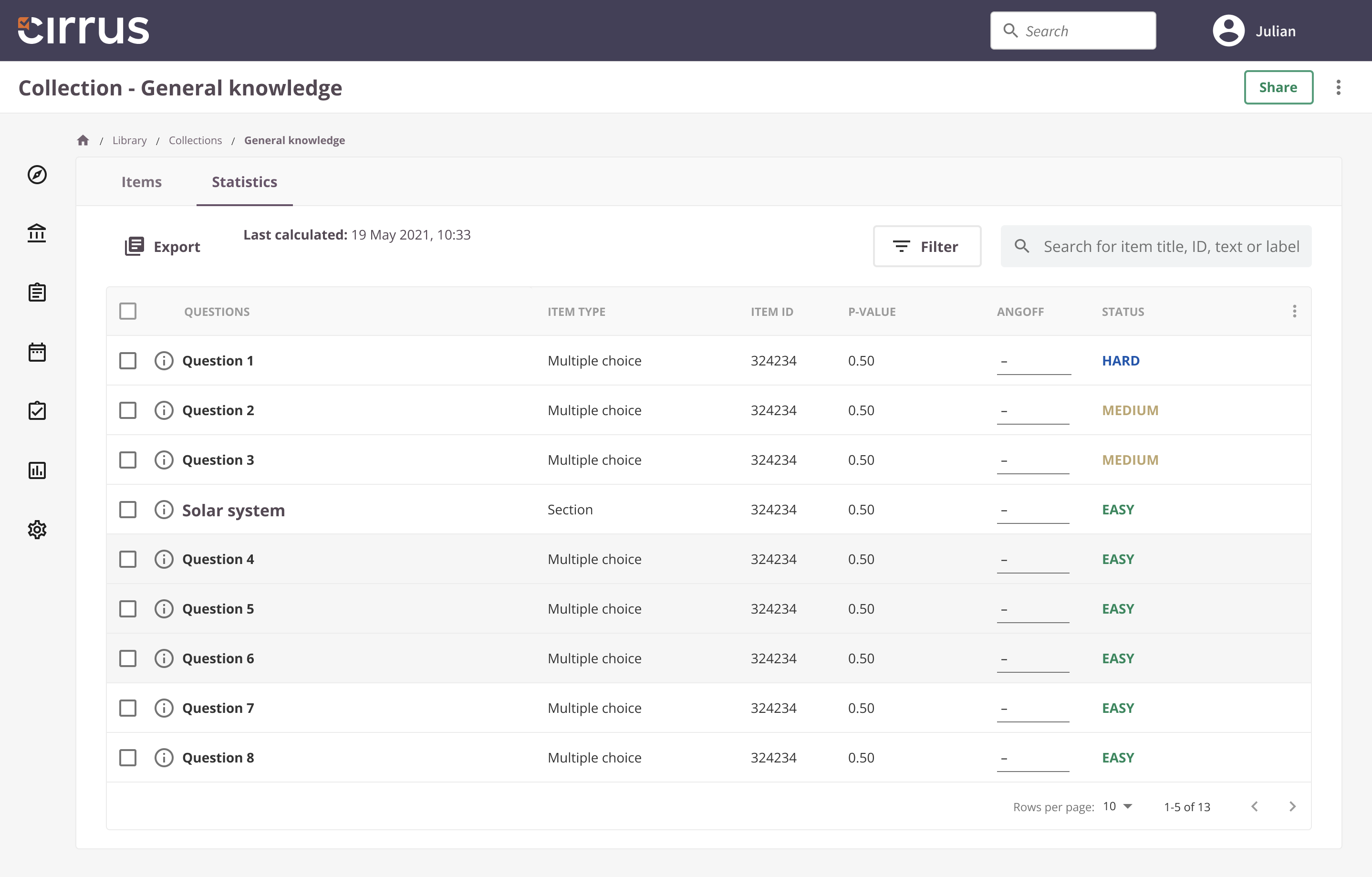 Psychometric data gives the author insight into the performance of the items and assessments
Psychometric data gives the author insight into the performance of the items and assessments
2. Creating Assessments
Cirrus has very powerful assessment creation functionality, including blueprint, multiple forms, versioning and collaborative authoring. Combined with automatic collection of psychometric data you can be ensured that the assessments will be of the highest quality and valid and reliable for your learners.
A typical assessment process look as follows:
- The item author creates an item bank with questions
- He/she shares the item bank with a colleague and makes that person a reviewer
- The reviewer checks the items and accepts them or sends them back with comments
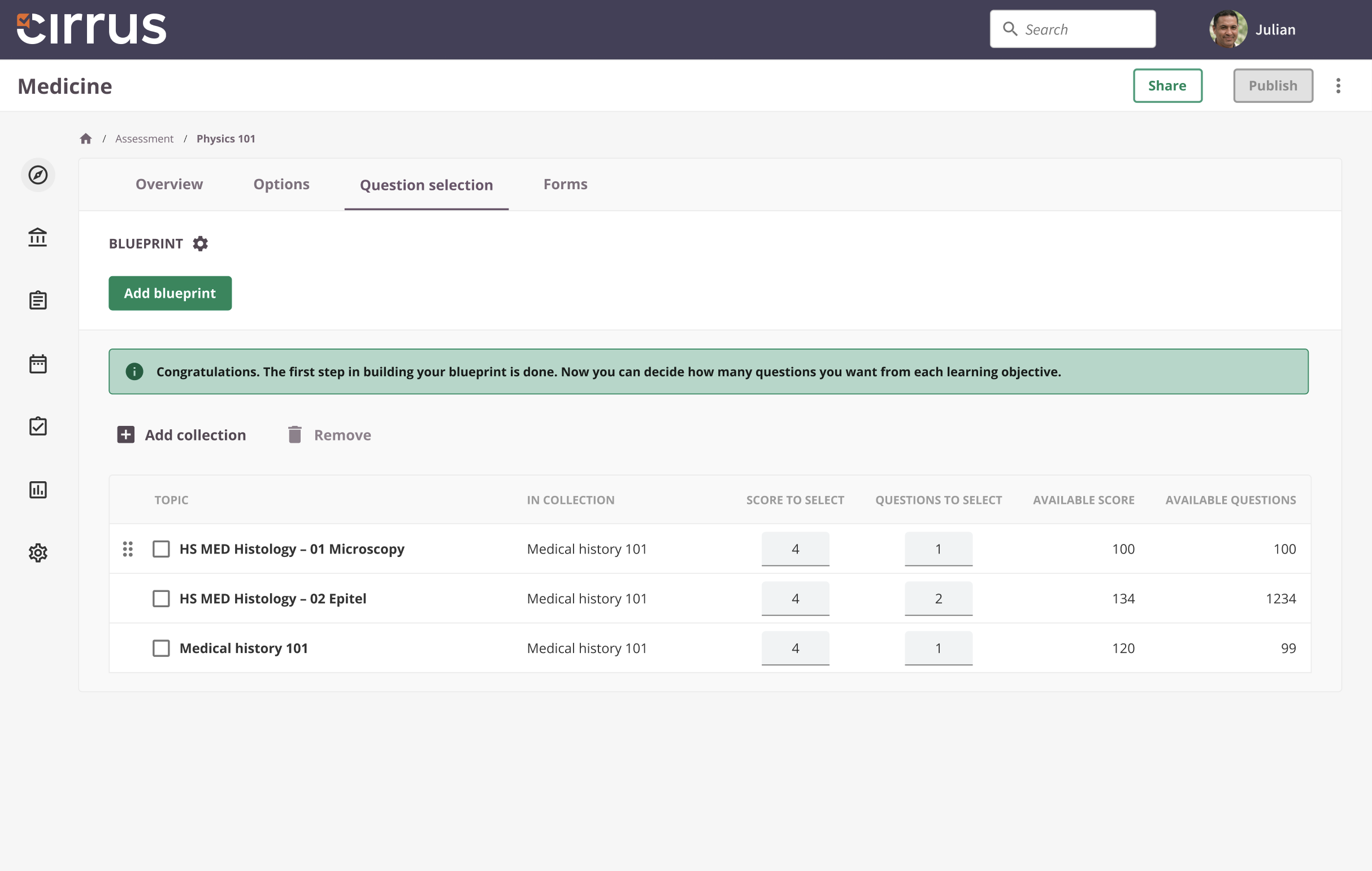 With the blueprint you have full control of what you want to assess (make the assessment valid)The items are accepted and set to Live
With the blueprint you have full control of what you want to assess (make the assessment valid)The items are accepted and set to Live- The assessment author creates an assessment and shares it with a reviewer
- The assessment author sets up a blueprint which pulls questions from the item bank
- The assessment author creates one or more forms (variants of the assessment)
- The reviewer checks the blueprint to make sure it matches the expected topics of the exam
- The reviewer checks if the forms are psychometrically balanced
- If accepted, the assessment author publishes the assessment
- The scheduler schedules the assessment for a group of candidates on a certain date
- The exam is sat by the candidates
- If the assessment contains human-marked questions, the marking coordinator sets up a marking workflow
- The marker(s) starts assessing the exam
- The marker/coordinator publishes the results to the candidates
3. Delivering assessments
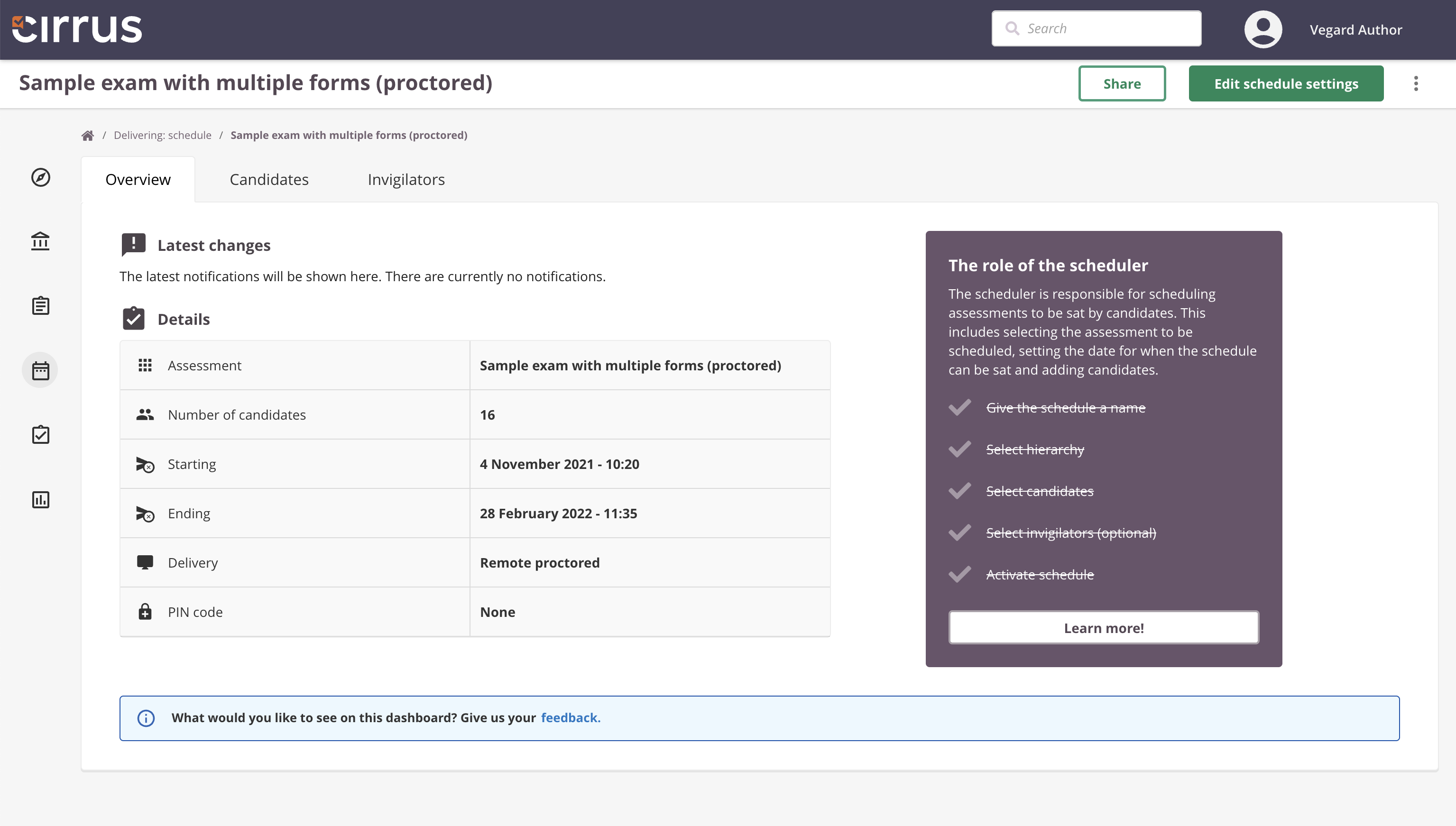 The cheduler(s) have a convenient dashboard where they can find relevant information about the schedule as well as an overview of latest changes to the scheduleOnce the assessments have been published, they can be scheduled. This can be done either through the user interface of Cirrus or through external systems, using our API's. Scheduling can be done centrally or de-centrally (by exam centres). Scheduled assessments can be delivered on-screen, on paper, or as remote proctored assessments.
The cheduler(s) have a convenient dashboard where they can find relevant information about the schedule as well as an overview of latest changes to the scheduleOnce the assessments have been published, they can be scheduled. This can be done either through the user interface of Cirrus or through external systems, using our API's. Scheduling can be done centrally or de-centrally (by exam centres). Scheduled assessments can be delivered on-screen, on paper, or as remote proctored assessments.
Cirrus is focused on the high-stakes testing market where failure is not an option. We therefore spend substantial time on making sure the application is as secure and robust as possible.
We understand as no other how important it is for you to trust the assessment platform. We have implemented military-grade encryption, fail-safes in case of Internet connection loss, monitoring of the exam sessions and much more.
On-screen and paper-delivery
Assessment created in Cirrus can be delivered in 2 different ways; the most commonly used is on-screen delivery, and the other method is paper-delivery.
Cirrus has a print and scan module which allows users to print assessments, which in turn can be scanned using specialized software. This will allow you to automatically send the candidates results directly back to Cirrus (additional module).
The candidate experience
There are several ways the candidates can access Cirrus. Most commonly is to implement single-sign-on, where they log in using an identity management system. The candidate has access to their own Cirrus dashboard, where upcoming and completed assessments will be available.
The Cirrus platform is fully web-based and no software is needed. It works with any modern browser running the latest update.
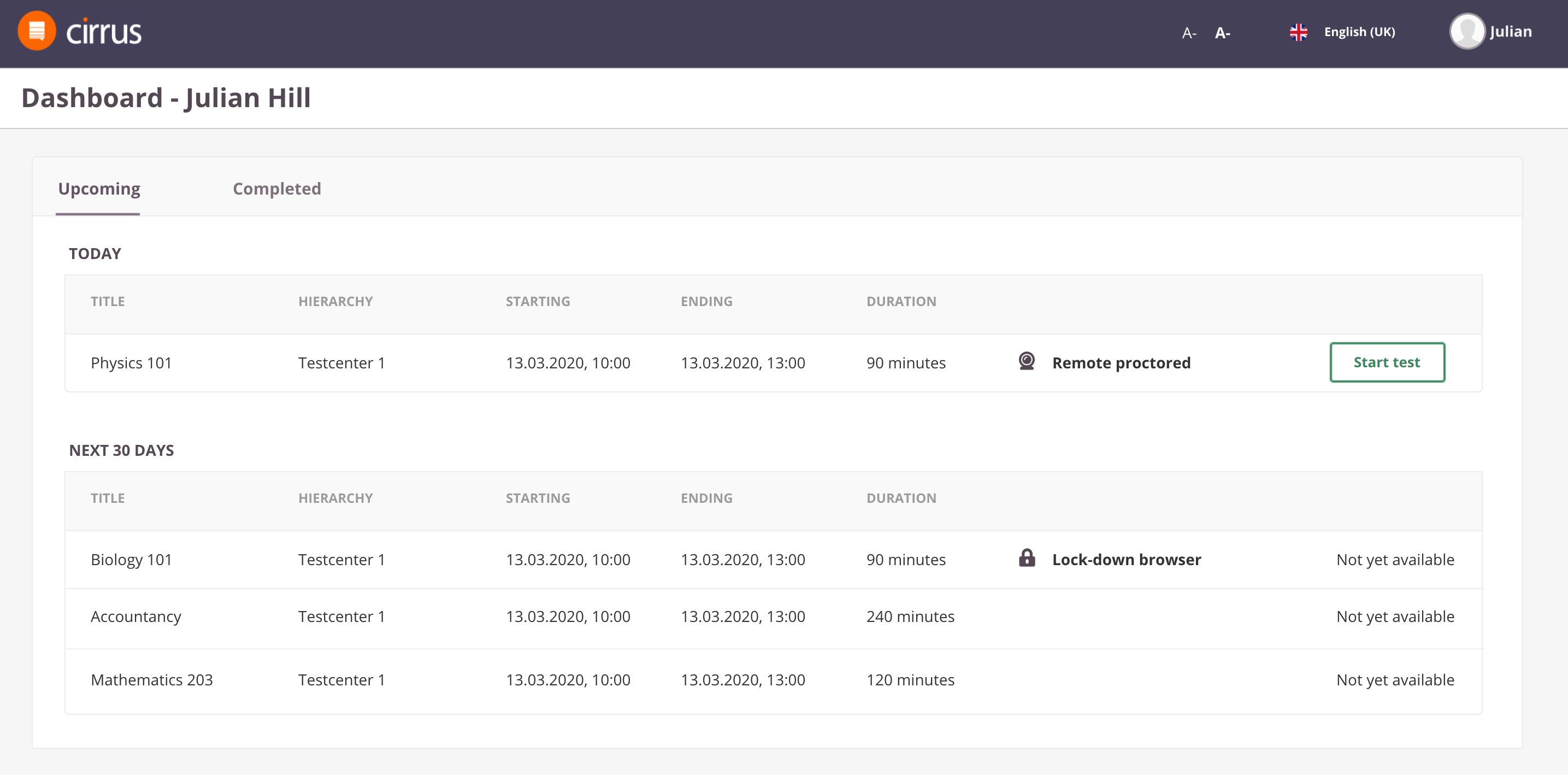 On the candidate dashboard the candidate can view all upcoming assessments as well as results of previous sat assessments (if allowed)The only exception is when running a remote proctored exam through Proctorio, where a small Google Chrome extension needs to be installed. See below for more information on our integrations
On the candidate dashboard the candidate can view all upcoming assessments as well as results of previous sat assessments (if allowed)The only exception is when running a remote proctored exam through Proctorio, where a small Google Chrome extension needs to be installed. See below for more information on our integrations
Usability and special needs
Cirrus is committed to the usability guidelines set out in WCAG (web content accessibility guidelines). This includes facilities for learners with special needs.
For example, it is possible to give extra time to specific users. Learners can adjust the text size, and we also have integration with Readspeaker to give users a powerful text-to-speech functionality.
Once the candidate has started the assessment, he/she will be able to navigate through the questions (either linear or free navigation). After submitting the test, the candidate will see results (if allowed).
Below is an example of a report that can be provided immediately after submitting the test (score report):
 It's possible to give your candidates immediate access to the results of their tests.
It's possible to give your candidates immediate access to the results of their tests.
Invigilation in Cirrus
Cirrus included a convenient invigilation dashboard where the exam sessions can be monitored. This works independent of the remote proctoring solution.
The invigilator can view who logged in, started the exam and handed in. The invigilator can also interact with the test takers by pausing the exam, give extra time to candidates or send direct messages to them.
Moreover, it’s also possible for the invigilator to see if candidates have connection problems and view extensive logs for each candidate. When remote proctoring is used, invigilators can view the proctored recordings.
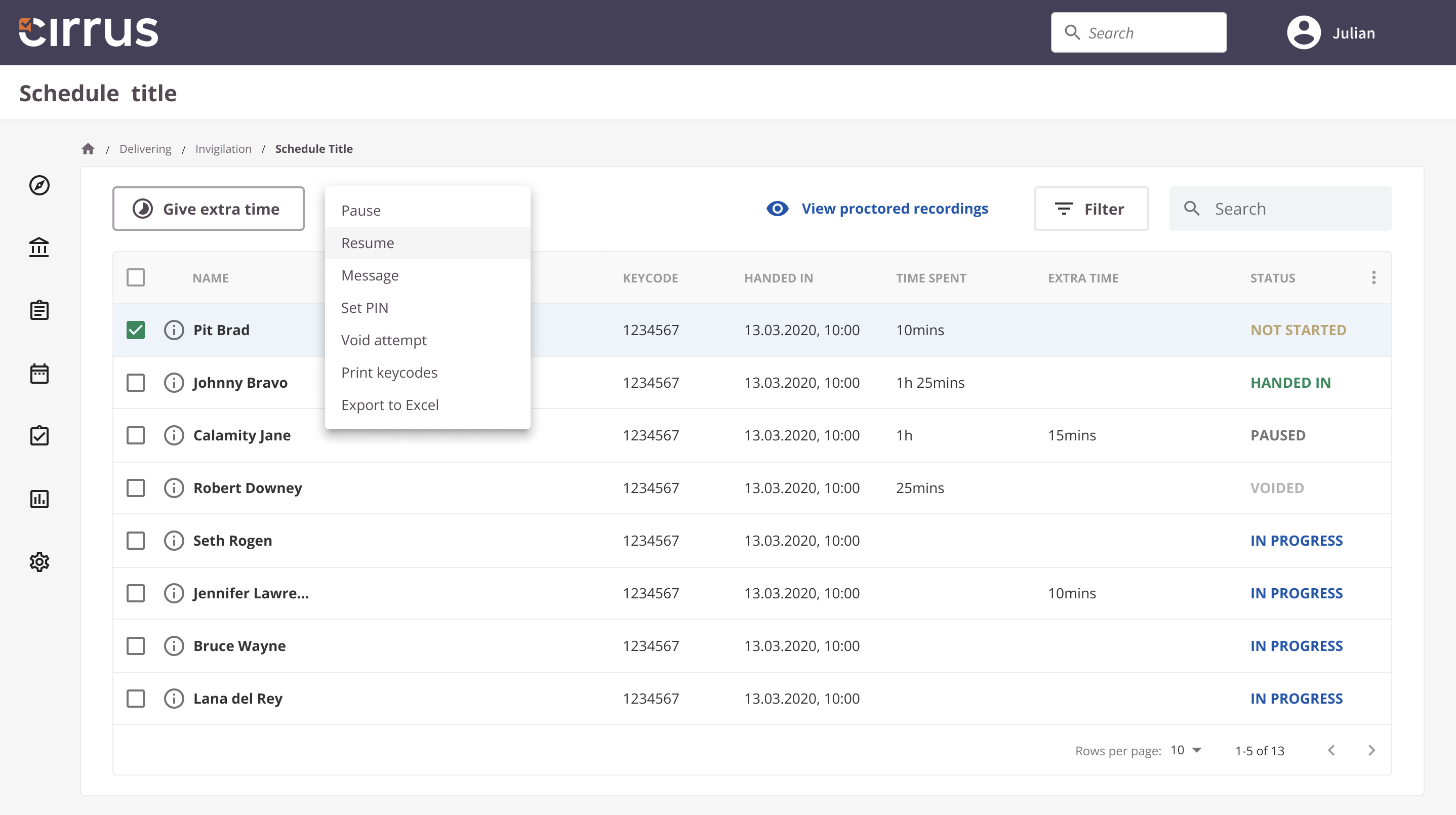 4. Marking in Cirrus
4. Marking in Cirrus
The marking tool in Cirrus is a fully integrated part of the Cirrus platform and is build as a powerful tool for scoring and assess human-marked questions. The marking workflow supports:
- Single or dual (blind) marking
- Allocation of markers by candidates or items
- Random or fixed allocation of markers
- Sharing annotations between assessors
- Anonymous marking
- Moderation based on business rules or sample moderation
Once the marking workflow has been set up, the allocated markers can start marking. The markers have a powerful tool at their disposal, that includes possibilities to annotate directly into the candidate response, score criteria (rubrics), compare with marking scheme, sharing scoring/annotations with co-assessors and much more.
One very convenient feature for the markers is the possibility to view their progress. Imagine if you have hundreds of scripts to mark. How convenient would it be to know how far you have progressed? How much you still need to mark, which questions have been marked by your colleagues etc.
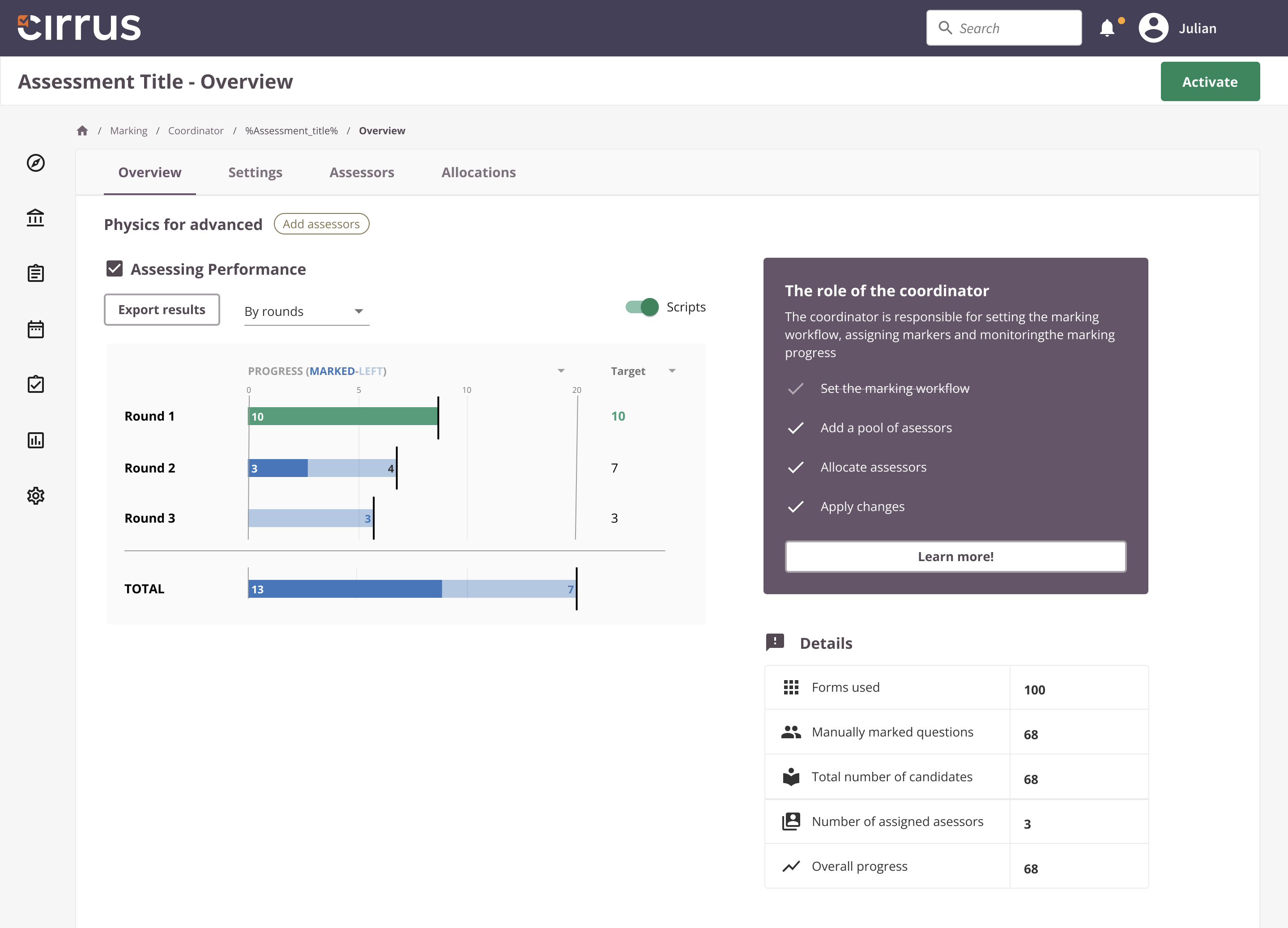 Setting up marking workflow is easy.
Setting up marking workflow is easy.
Rescoring in Cirrus
It’s possible to rescore assessments after they have been delivered. This can be useful when, for example, certain questions perform poorly, and you want to exclude them from the results calculation. Re-scoring can also be used to adjust the items in the assessment after it has been sat by the candidates. This could include mistakes in the scoring or marking scheme discovered only afterwards.
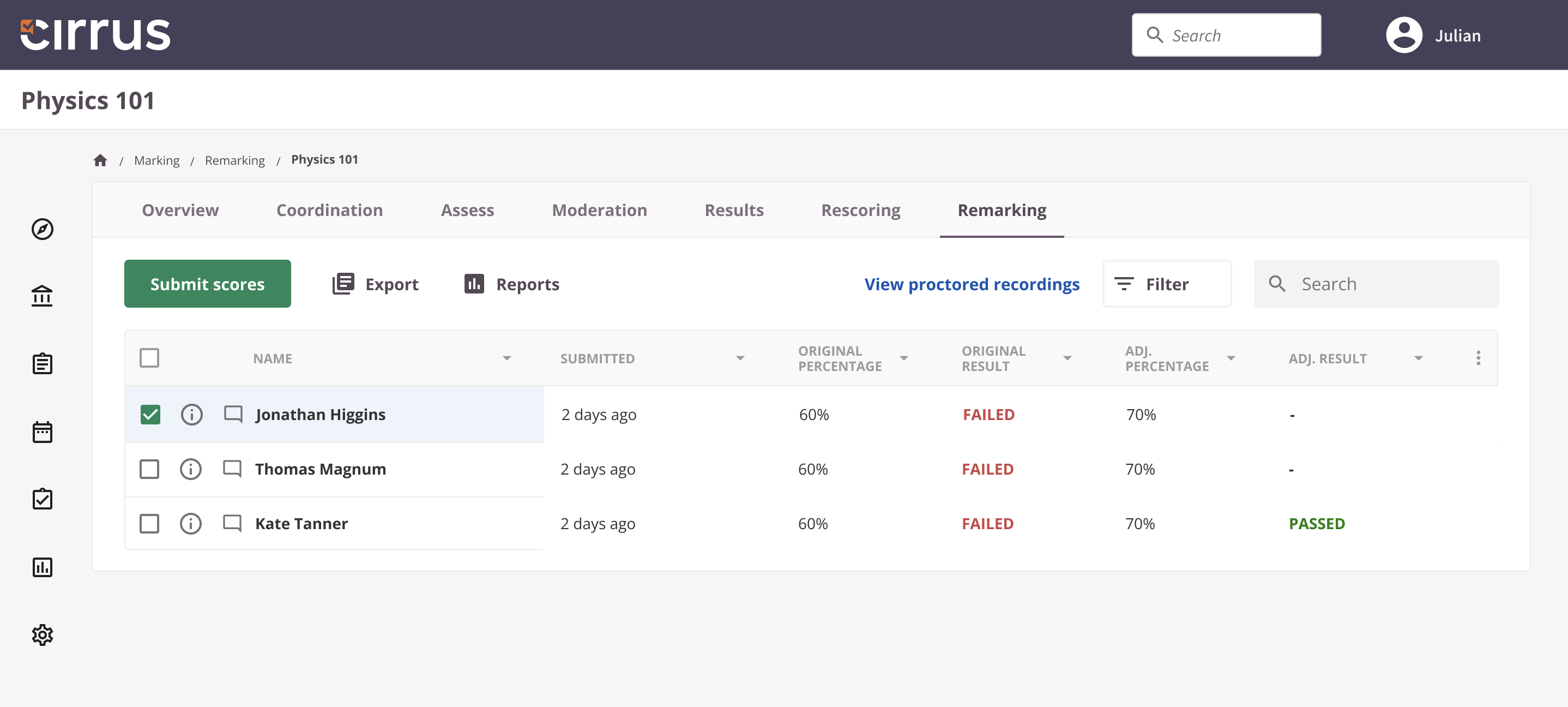 Candidate results can be flagged for re-marking.Candidate results
Candidate results can be flagged for re-marking.Candidate results
Results can be released to candidates immediately or during a scheduled review session. By scheduling a review session, you can control when the candidates are able to view their results. So you can choose to publish the results to candidates for example between 9 and 10 AM on a certain date.
Candidate appeals
Candidate results can be flagged for re-marking. This allows you to re-mark the candidate scripts. Very useful in case of candidate appeals.
5. Reporting
Reporting in Cirrus can be divided into two areas; candidate results and psychometric reporting. Reports can be pulled from Cirrus using our reporting API’s.
It’s worth mentioning that we are working on several improvements to reporting which includes the possibility for data-mining. This will allow users to query the database to get the data they need. This can, for instance, be displayed in a business intelligence tool.
All reports in Cirrus can also be exported to Excel.
Integrations in Cirrus
The Cirrus Platform supports industry standards like SAML 2.0 for Single Sign-On and IMS Global's LTI that merely require configuration. We also provide a REST API that allows you to programmatically manage all key data of the platform.
Are you a developer? Then please visit the technical part of our Knowledge Base here.
We've also arranged for some ready made integrations to allow the use of remote proctoring, Office365, ReadSpeaker for text to speech options and SOWISO for higher education math and statistics.
Remote proctoring
Remote proctoring allows the candidates to submit their assessment from home, in a secure environment as they are being monitored by a remote proctor. Using remote proctoring also allows candidates to select a preferred time for taking the assessment.
- Safe Exam Browser (SEB):a free to use, open source lockdown browser that we made compatible with Cirrus.
- ProctorU:a paid service offering live proctoring solutions.
- Proctorio: allows forfully automated proctoring,using advanced Artificial Intelligence that automatically detects cheating behaviour.
Office365
We are very proud of our integration with MS Office365 which allows the use of Word, Excel and PowerPoint within the Cirrus application.
ReadSpeaker
The ReadSpeaker add-on adds a text to speech tool to Cirrus. This is especially useful for people with poor eyesight.
The service is not available by default. Please reach out to us via the Customer Portal for more details on activating it.
SOWISO
Our mathematical question type add-on consists of an integration with SOWISO; a secure test environment for higher education math and statistics.
The question type is not available by default. Please reach out to us via the Customer Portal for more details on activating it.




